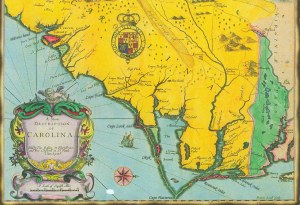Archive
“Staining everything of so perfect a Crimson color”: Two Early Descriptions of Carolina Wine
Thomas Pinney writes that the first two colonies in what is now North Carolina, known as the Province of Carolina until 1712, did not appear to produce any wine. In what is now South Carolina there was hope for the production of wine in the 1670s but again no documentation that anything was produced. In 1680 the first organized group of Huguenots landed in South Carolina with one of their goals to produce wine. In 1682 both Thomas Ashe and Samuel Wilson give accounts of wine being made in the Carolinas. Pinney goes on to write that in 1683 the Huguenot Frances de Rousserie was awarded a grant of 800 acres due to his attempts at propagating wine in Carolina. Early attempts at further winemaking appear to end with Sir Nathaniel Johnson who arrived in 1690 and went on to plant a considerable vineyard.
William Salmon (1644-1713) was a medical empiric self-published author who is famous, in part, for having written the first description of the tomato in the British colonies. William Salmon left England in 1687 for the colonies where he traveled throughout New England, Virginia, Carolina, and the Caribbean. He returned to England in 1690. In 1710 he published the first of two folios of his major work Botanologia: The English Herbal, or History of Plants. There are many references to plants he observed throughout his travels but most interesting is his description of Carolina wine in Chapter DCCXXIV Of the VINE. This wine would have been tasted in 1687-1690 or five to eight years after the first two descriptions.
“22. The Carolina, or Virginian Red Grape, which is a small Grape, and yields a very deep Blood red Wine. I remember that when I was on Carolina, one Garrat a French-Man, made in one Year about two Hogshead of it, (from Vines which grew Wild in the Woods) which was not so lusciously Sweet as Tent, but when I drank of it at his House, I then thought it to be the pleasantest Wine I ever drank in my whole Life: It was very fine, not of so thick a Body as Tent, but of a profound Red, staining everything of so perfect a Crimson color, as not easily to be obliterated, tho’ upon the spot.”
As for this description of the wine we find similarity one decade later. In the letter written by Richard Coote, 1st Earl of Bellomont, the Governor of New York, to the Council of Trade and Plantations on 28 November 1700. In a section discussing the cultivation of vineyards for the production of wine for the Dominions of the Crown he writes of the Boston merchant Mr. Bourn. Mr. Bourn had come from Carolina in February 1700 and “assur’d me he drank very good wine there of their own growth, that was as strong as any Lisbon or Port-wine he ever tasted.” Richard Coote continues, “Without doubt SouthCarolina would produce wine that would equal any we have from Spain or Portugal, and these more Northern Plantations, as far as the Naraganset country, would produce a lighter sort of wine, such as Burgundy and Bordeaux claret.”
These two descriptions are part of the earliest tasting notes of wine produced in the British Colony of Carolina. I must admit they do sound tasty.
References:
‘America and West Indies: November 1700, 26-30’, Calendar of State Papers Colonial, America and West Indies, Volume 18: 1700 (1910), pp. 664-706. URL: http://www.british-history.ac.uk/report.aspx?compid=71379&strquery=carolina wine Date accessed: 10 June 2013.
Oxford Dictionary of National Biography. URL: http://www.oxforddnb.com/view/article/24559 Date accessed: 10 June 2013.
Pinney, Thomas. A History of Wine in American: from beginnings to prohibition. Volume 1. University of California Press, Berkeley, 1989.
Salmon, William. Botanologia: The English Herbal or, History of Plants. I. Dawks, London, 1710.
Smith, Andrew F. The Tomato in America. University of South Carolina Press, 1994.
References I wished to consult but could not:
Moore, Norman. Life of William Salmon, 1897.
S. J. Childs, ‘The ubiquitous Dr Salmon’, Canadian Medical Association Journal. Journal de l’Association Médicale Canadienne, 66 (1970)

